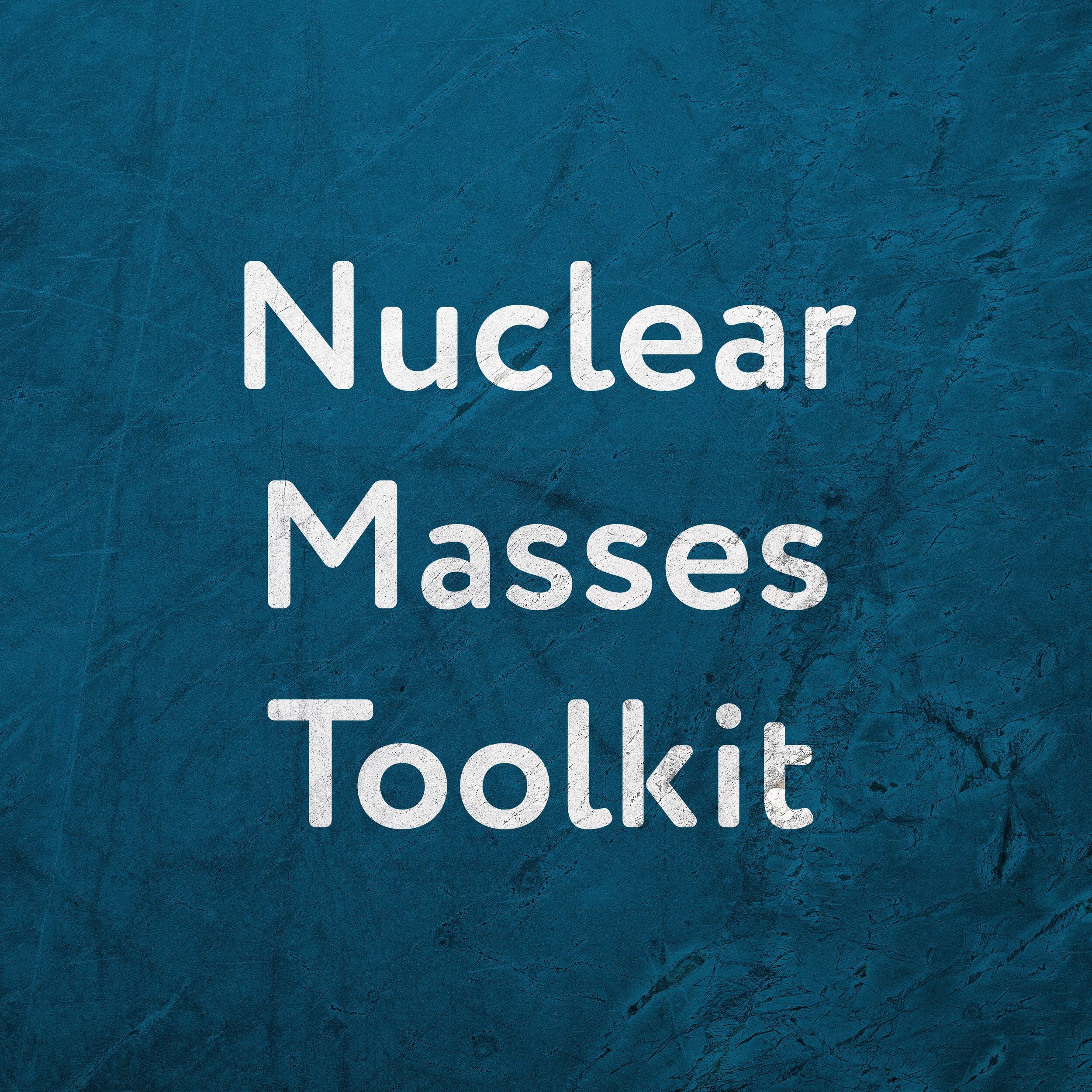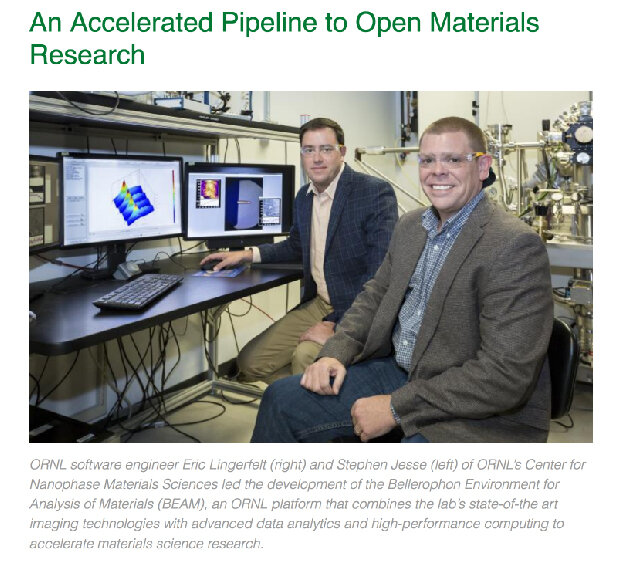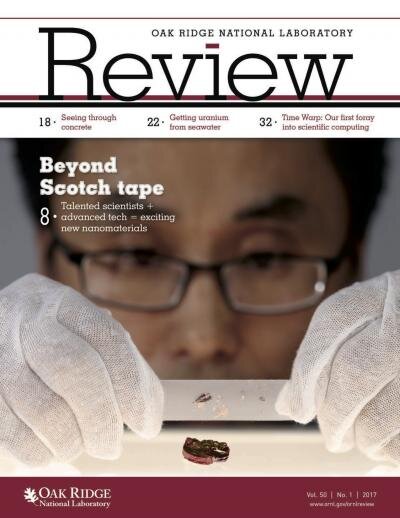Bellerophon Environment for Analysis of Materials
BEAM enables material scientists to easily access and utilize high performance computing, machine learning algorithms, cloud-based data management, and robust visualization.
Learn more
As a Technical Staff Member at ORNL, Eric Lingerfelt of Pandia Software led the design and development of the Bellerophon Environment for Analysis of Materials (BEAM). BEAM enables scientists at DOE User Facilities, such as ORNL’s Center for Nanophase Materials Sciences and Spallation Neutron Source, to leverage the integrated computational and analytical power of ORNL’s Compute And Data Environment for Science (CADES) and the Oak Ridge Leadership Computing Facility (OLCF) to perform near real-time scalable machine learning workflows and data analysis. At the core of this computational workflow system is a web and data server located at CADES that enables multiple, concurrent users to securely upload and manage data, execute machine learning workflows, and interactively explore results through custom visualization services. BEAM’s long-term data management capabilities utilize CADES’ petabyte-scale file system and enable users to easily manipulate remote directories and uploaded data in their private data storage area as if they were browsing on a local workstation. In addition, the framework facilitates user workflow needs by enabling integration of scalable machine learning algorithms and authenticated, “push-button” execution of dynamically generated workflows employing these algorithms on Titan, Eos, and Rhea at OLCF, as well as compute clusters at CADES. BEAM supports machine learning workflows that execute parameterization, principal component analysis, k-means clustering, and image denoising of SPM and STEM data (developed in collaboration with ORNL’s Institute for Functional Imaging of Materials) using a variety of high performance computing implementations including FORTRAN, R with pdbR, Python, and Java with Apache Spark – all tightly bound with parallel HDF5. In addition, BEAM offers near real-time optimization of inelastic and quasi-elastic neutron scattering data utilizing Titan (developed in collaboration with the ACUMEN project and ORNL’s Center for Accelerating Materials Modeling).
Awards
ORNL Significant Event Award, 2016. This award was given in recognition of significant contribution to the BEAM (Bellerophon Environment for Analysis of Materials) Project Designed and Developed to Integrate the Computational and Analytical Power of HPC (High Performance Computing) with Advanced Instrumentation at CNMS (Center for Nanophase Materials Sciences) and SNS (Spallation Neutron Source) to Perform Near Real-time, Scalable Data Analysis and Computational Modeling.
Publications
V. E. Lynch, J. B. Calvo, E. Deelman, R. F. da Silva, M. Goswami, Y. Hui, E. Lingerfelt, and J. S. Vetter, “Distributed workflows for modeling experimental data,”, 2017 IEEE High Performance Extreme Computing Conference (HPEC), Waltham, MA, 2017, pp. 1-5.
E. J. Lingerfelt, A. Belianinov, E. Endeve, O. Ovchinnikov, S. Somnath, J. M. Borreguero, N. Grodowitz, B. Park, R. K. Archibald, C. T. Symons, S. V. Kalinin, O. E. B. Messer, M. Shankar, and S. Jesse, “BEAM: A computational workflow system for managing and modeling material characterization data in HPC environments”, International Conference on Computational Science 2016, Procedia Computer Science, Vol. 80, Pages 2276-2280, 2016.
S. Kalinin, E. Strelcov, A. Belianinov, S. Somnath, R. Vasudevan, E. J. Lingerfelt, R. K. Archibald, C. Chen, R. Proksch, N. Laanait, and S. Jesse, “Big, Deep, and Smart Data in Scanning Probe Microscopy”, ACS Nano, 2016, 10 (10), pp 9068–9086.
News Releases
GeoCODES is a cloud-based data discovery platform comprised of intuitive web-based tools, REST APIs, and Python, R, and MATLAB eNotebooks that enables data discovery through Google.
Learn more
As Technical Officer of the NSF's EarthCube Program, Eric Lingerfelt of Pandia Software led the design and development of GeoCODES: The Geoscience Cyberinfrastructure for Open Discovery in the Earth Sciences. GeoCODES is a cloud-based data search and discovery platform comprised of intuitive web-based tools, REST APIs, and Python, R, and MATLAB notebook integration for a variety of services. The GeoCODES platform enables data registration, discovery, and access by applying the Schema.org web standard for metadata markup using the JSON-LD format. By publishing resource metadata in this format, data producers automatically register data products with organic search engines like Google. Datasets can then be shared and integrated with other data-centric computional software tools like ESRI's Living Atlas of the World. GeoCODES' development was managed by the EarthCube Science Support Office at UCAR in Boulder, CO with collaborators from the Consortium for Ocean Leadership, the Biological and Chemical Oceanography Data Management Office, Instrumental Software Technologies, Inc., the Ronin Institute, the U.S. Geoscience Information Network, and the University of California at San Diego.

Bellerophon enables real-time visualization and software engineering of massively parallel astrophysics simulations.
Learn more
Core-collapse supernovae are nature’s mechanism for producing the elements heavier than oxygen, which make up our bodies and the world around us. By designing and implementing multi-dimensional, multi-physics high performance computing applications, scientists can leverage the power of supercomputing platforms to explore this phenomenon. The complexity, pace of ongoing development and widely distributed collaborators of these astrophysics simulations present many challenges. In order to address those challenges, the Bellerophon software system provides software engineering, real-time visualization, and data analysis of high performance computing simulations and seamlessly integrates with multiple computing centers such as the National Energy Research Scientific Computing Center. Pandia Software currently maintains and enhances Bellerophon with collaborators from the ORNL Physics Division and the Oak Ridge Leadership Computing Facility.
Awards
ORNL Computing and Computational Sciences Directorate (CCSD) Distinguished Contributor Award, 2011. This award was given in recognition of the development of the Bellerophon software system.
Publications
S. W. Bruenn, E. J. Lentz, W. R. Hix, A. Mezzacappa, J. A. Harris, O. E. B. Messer, J. M. Blondin, M. A. Chertkow, E. Endeve, E. J. Lingerfelt, P. Marronetti, K. Yakunin. “The Development of Explosions in Axisymmetric Ab Initio Core-Collapse Supernova Simulations of 12-25 MSolar Stars”, Astrophysical Journal, Volume 818, Number 2, 2016.
E. Lingerfelt and B. Messer. “Bellerophon: A Computational Workflow Environment for Real-time Analysis, Artifact Management, and Regression Testing of Core-Collapse Supernova Simulations”, The International Conference for High Performance Computing, Networking, Storage and Analysis (Supercomputing 2015), Nov. 17, 2015.
K. N. Yakunin, A. Mezzacappa, P. Marronetti, S. Yoshida, S. W. Bruenn, W. R. Hix, E. J. Lentz, O. E. B. Messer, J. A. Harris, E. Endeve, J. M. Blondin, E. J. Lingerfelt. "Gravitational wave signatures of ab initio two-dimensional core collapse supernova explosion models for 12–25 MSolar stars", Phys. Rev. D, Vol. 92, 2015.
E. J. Lingerfelt, O. E. B. Messer, S. S. Desai, C. A. Holt, E. J. Lentz. “Near Real-time Data Analysis of Core-Collapse Supernova Simulations With Bellerophon”, International Conference on Computational Science 2014, Procedia Computer Science, Vol. 29, Pages 1504-1514, 2014.
A. Mezzacappa, S. W. Bruenn, E. J. Lentz, W. R. Hix, O. E. B. Messer, J. A. Harris, E. J. Lingerfelt, E. Endeve, K. N. Yakunin, J. M. Blondin, P. Marronetti. “Two- and Three-Dimensional Multi-Physics Simulations of Core Collapse Supernovae: A Brief Status Report and Summary of Results from the "Oak Ridge" Group”, Numerical Modeling of Space Plasma Flows: ASTRONUM-2013, ASP Conference Series, Vol. 488, Pages 102-113, 2014.
S.W. Bruenn, A. Mezzacappa, W.R. Hix, E.J. Lentz, O.E.B. Messer, E.J. Lingerfelt, J.N. Blondin, E. Endeve, P. Marronetti, K. N. Yakunin. “Axisymmetric Ab Initio Core-Collapse Supernova Simulations of 12-25 MSolar Stars”, ApJ 767, no. 1, L6, Apr. 10 2013.
E. J. Lingerfelt, O. E .B. Messer, J. A. Osborne, R. D. Budiardja, A. Mezzacappa. “A Multitier System for the Verification, Visualization and Management of CHIMERA”, International Conference on Computational Science 2011, Procedia Computer Science, Vol 4, Pages 2076-2085, 2011.
S.W. Bruenn, E.J. Lentz, E.J. Lingerfelt, A. Mezzacappa, W.R. Hix, J.N. Blondin, O.E.B. Messer, P. Marronetti. “Neutrinos and Supernovae”, Hamburg Neutrinos from Supernova Explosions (HAvSE 2011) Proceedings, DESY, Hamburg, Germany, Dec 2011.
Computational Infrastructure for Nuclear Astrophysics (CINA)
With over 100 software tools and users from 39 countries and 186 institutions throughout the globe, CINA enables anyone to quickly and easily configure, execute, and visualize nova and supernova simulations.
Learn more
The elements, which make up our bodies and the world around us, are produced in violent stellar explosions. Computational simulations of the element creation processes occurring in these cataclysmic phenomena are complex calculations that track the abundances of thousands of species of subatomic nuclei that are interrelated by ~60,000 thermonuclear reaction rates stored in continually updated databases. Previously, delays of up to a decade were experienced before the latest experimental reaction rates were used in astrophysical simulations. The Computational Infrastructure for Nuclear Astrophysics (CINA), freely available at the website nucastrodata.org, reduces this delay from years to minutes! With over 100 unique software tools developed since 2003, CINA comprises a “lab-to-star” connection. The system enables users the capability to robustly simulate, share, store, analyze and visualize explosive nucleosynthesis events such as novae, X-ray bursts and core-collapse supernovae and upload, modify, merge, store and share the complex input data required by these simulations. It is the only cloud computing software system in this field and it is accessible via an easy-to-use, web-deliverable Desktop application. Pandia Software currently maintains and enhances CINA with collaborators from the ORNL Physics Division.
Awards
ORNL Computer Science and Mathematics Division (CSMD) Most Distinguished Award for a Special Contribution, 2014. This award was given in recognition of the development of the Computational Infrastructure for Nuclear Astrophysics Cloud-based Software as a Service System for Modeling Nuclear Reaction Processes.
Publications
M. S. Smith, T. Sunayama, W. R. Hix, E. J. Lingerfelt, C. D. Nesaraja. “ Bottlenecks and Waiting Points in Nucleosynthesis in X-ray bursts and Novae ”, Proc. 10th Int. Symp. on Origin of Matter and Evolution of Galaxies, Mar. 8 - 10, 2010, AIP Conf. Proc. 1269, pp. 439-441, 2010.
M. S. Smith, E. J. Lingerfelt, C. D. Nesaraja, W. R. Hix, L. F. Roberts, H. Koura, G. M. Fuller, D. Tytler. “ Nuclear Data for Astrophysics: Resources, Challenges, Strategies, and Software Solutions ”, International Conference on Nuclear Data for Science and Technology 2007, ND 2007 349, 2008.
M. S. Smith, R. Cyburt, H. Schatz, M. Wiescher, K. Smith, S. Warren, R. Ferguson, E. J. Lingerfelt, K. Buckner, C. D. Nesaraja. 2007. “ Thermonuclear Reaction Rate Libraries and Software Tools for Nuclear Astrophysics Research ”, Proc. 10th Int. Symp. on Origin of Matter and Evolution of Galaxies, Dec. 4 - 7, 2007, AIP Conf. Proc. 1016, pp. 466-468, 2008.
T. Sunayama, M. S. Smith, E. J. Lingerfelt, K. Buckner, W. R. Hix, C. D. Nesaraja. “
Waiting Points in Nova and X-ray burst Nucleosynthesis
”, Proc. 10th Int. Symp. on Origin of Matter and Evolution of Galaxies, Dec. 4 - 7, 2007, AIP Conf. Proc., 2008.
B. H. Moazen, D. W. Bardayan, J. C. Blackmon, K. Y. Chae, K. Chipps, C. P. Domizioli, R. Fitzgerald, U. Greife, W. R. Hix, K. L. Jones, R. L. Kozub, E. J. Lingerfelt, R. J. Livesay, C. D. Nesaraja, S. D. Pain, L. F. Roberts, J. F. Shriner Jr., M. S. Smith, J. S. Thomas. “
Measurement of the 183 keV Resonance in 17O(p,α)14N Using a Novel Technique
”, Phys. Rev. C 75, 2007.
D. W. Bardayan, J. A. Howard, J. C. Blackmon, C. R. Brune, K. Y. Chae, W. R. Hix, M. S. Johnson, K. L. Jones, R. L. Kozub, J. F. Liang, E. J. Lingerfelt, R. J. Livesay, S. D. Pain, J. P. Scott, M. S. Smith, J. S. Thomas, D. W. Visser. “ Astrophysically Important 26Si States Studied with the 28Si(p,t)26Si Reaction - II. Spin of the 5.914- MeV 26Si Level and Galactic 26Al Production ”, Phys. Rev. C 10, 2006, 74(4).
M. Smith, E. J. Lingerfelt, J. P. Scott, C. D. Nesaraja, K. Chae, H. Koura, L. F. Roberts, W. R. Hix, D. W. Bardayan, J. C. Blackmon. “ New features in the Computational Infrastructure for Nuclear Astrophysics ”, Proceedings of the International Symposium on Nuclear Astrophysics - Nuclei in the Cosmos IX, Geneva, Switzerland, June 25-30, 2006, Proceedings of Science, Pos (NiC-IX) 180, 2006.

Nuclear Masses Toolkit
The Nuclear Masses Toolkit provides a one-stop-shop for management, statistical comparison, and visualization of large scale nuclear physics data sets.
Learn more
A knowledge of the masses of subatomic nuclei forms a crucial foundation for research in basic and applied nuclear science, as well as in astrophysics. New accelerator facilities and new detection systems have enabled researchers around the world to make more, and much more precise, nuclear mass measurements. Freely available at the website nuclearmasses.org, the Nuclear Masses Toolkit (NMT) enables research scientists and non-experts the ability to share, visualize, and analyze nuclear mass information in a robust and intuitive way. Once registered, NMT users can upload mass datasets, store them, and share them with colleagues as well as compare mass datasets with ones from peer-reviewed research. The NMT’s suite of visualization tools allows users to quickly and easily create highly customized data views of several quantities and their differences when compared to other datasets. The data views not only include 1D plots but also interactive 2D plots on the chart of the nuclides that compare values such as mass excess, Q-values, and separation energies. Datasets may also be analyzed by average RMS differences and RMS difference as a function of atomic number, neutron number, and mass number. Pandia Software currently maintains and enhances the NMT with collaborators from the ORNL Physics Division.
Publications
M. S. Smith, E. J. Lingerfelt, C. D. Nesaraja, H. Koura, F. Kondev. “Nuclear Mass Visualization and Analysis at nuclearmasses.org”, The 10th International Symposium on Origin of Matter and Evolution of Galaxies, Osaka (Japan), Mar. 8-10, 2010, AIP Conf. Proc. 1269, pp. 442-444, 2010.
Big Bang Online
Big Bang Online enables anyone to quickly and easily compute quantities at the beginning of our Universe and compare and visualize theory versus observation.
Learn more
The Big Bang Online software suite allows anyone to create, run, visualize, and share custom cosmology calculations using Big Bang Nucleosynthesis theory. Accessible from bigbangonline.org, the software enables users to evaluate, manage, share, calculate and visualize thermonuclear reaction rates, primordial abundance observations, "Big Bang" cosmological simulations, and cosmological constraints on these simulations quickly and easily through its intuitive user interface. Pandia Software currently maintains and enhances Big Bang Online with collaborators from the ORNL Physics Division.
Publications
M. S. Smith, B. D. Bruner, R. L. Kozub, L. F. Roberts, D. Tytler, G. M. Fuller, E. J. Lingerfelt, W. R. Hix, C. D. Nesaraja. “Big Bang Nucleosynthesis: Impact of Nuclear Physics Uncertainties on Baryonic Matter Density Constraints”, Proc. 10th Int. Symp. on Origin of Matter and Evolution of Galaxies, Dec. 4 - 7, 2007, AIP Conf. Proc. 1016 pp. 403-405, 2008.














































